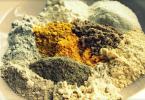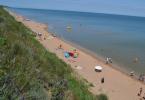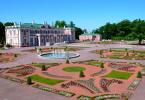Hradcanci Square is a place where you can endlessly turn your head, looking at spectacular architecture.
As a guide in Prague, during my tour of Prague, I tell interested people "what it is and where it comes from." Well, as soon as I'm not around, my " Free guide"To help everyone who is curious.
The Tuscan Palace in Prague is a wonderful Baroque contraption that deliciously decorates Hradcany Square.
In ancient times, on the site of this architectural charm, there were some houses, bought at the end of the 17th century by the Thun-Hohenstein family from the Lobkovets family.
By that time, the Thun-Hohensteins were well-known Tyrolean gentry, who had appeared in the annals of European historiography as early as the 11th century. For many centuries, these guys served the Holy Roman Empire as either the highest government officials or bishops and archbishops.
In the first half of the 17th century, finding themselves in the victorious Habsburg wake, the newly minted counts of Thun und Hohenstein gladly began to buy up luxury real estate and multiple Bohemian hectares.
In those days, the Thun-Hohensteins adored stylish baroque buildings, attracting prominent European architects to create them.
In 1685, Mikhail Oswald Thun-Hohenstein bought the same Lobkowicz houses a hundred meters from Prague Castle and began building a large beautiful meadow.
The scale of the planned palace can easily be called the apotheosis of the baroque ambitions of the Thun-und-Hohensteins of the era of Leopold I.
The counts did not spare money for their tower and, having arrived a little earlier in Prague, the architect Jean Baptist Matei promised to become their chief architect for a substantial fee.
After the registration of the necessary papers and the ritual strike on the hands, hammers, picks and shovels rattled in Hradchany.
The neighbor of Count Michael Oswald, Count Martinets, tried to protest against the daily rumble, however, the emperor, who intervened in the noble dispute, approved the construction of the palace in every possible way.
Count Michael introduced himself without waiting for the completion of construction work, and his brother, Count Maximilian, ceded the rights of ownership of the choir under construction to his sister. The same, in turn, assigned them to other relatives.
For all that, the pleasure of finishing the northern palace part fell to a completely outsider - the Princess of Saxe-Lauenburg from Schleswig-Holstein, the Countess of Mecklenburg and the Grand Duchess of Tuscany, the builder of a certain number of churches, cathedrals and all kinds of castles, an extremely pious person, a lover of protracted construction projects, long repairs and detailed reconstructions - to Anna Maria of Tuscany.
Under her rule, Vaclav Spaczek became the chief architect of the palace.
Anna Maria also did not live to see the end of construction. The act of acceptance and delivery of the completed object was signed by her daughter Maria Anna. Further, the Tuscan Palace went through the hands of the following children and grandchildren.
In 1803, Ferdinand Habsburg became the legitimate Prince of Tuscany.
Since that time, the Tuscan Palace in Prague became the property of the imperial dynasty.
By coincidence, in 1918, the new authorities said “Dosvidos, papa” to the gentlemen of the Habsburgs, and the Tuscan Palace was transferred to the balance of the Czechoslovak state.
Soon, employees of the Ministry of Foreign Affairs moved into its walls. At the end of the 20th century, reenactors became quite interested in the palace building, eventually turning it into what is visible in my photograph.
The monumental Tuscan Palace is now occupied by the Czech Ministry of Foreign Affairs, so the average visitor will not be able to get inside. But you can admire from the outside: magnificent baroque, magnificent sculptures and decorations on the facade, windows, arches, balconies - beautiful architecture!
Tuscan Palace (Toskánský palác), photo Zden Her
The Tuscan Palace (Toskánský palác) was built in the spirit of classical Roman baroque. The balustrade on the attic of the building is decorated with statues of Sēptem ārtes liberāles - the “seven free arts” of the Hellenistic era. At the corner of the palace is a statue of St. Michael, patron of the Thun-Hohenstein family. The facade is decorated with 2 coats of arms of the Dukes of Tuscany.
The history of the appearance of the palace
In 1689, Mikhail Oswald, Count of Thun-Hohenstein, decided to build a palace in the western part of the square, instead of several 14th-century houses. There were disagreements with the owners of neighboring buildings: the new palace would close their facades. The conflict was resolved in favor of the count by Emperor Leopold himself.
Palace in the Hradcany Square Ensemble, photo by Roland Christian Richter
The project of the palace was developed by 1690 by Jean-Baptiste Matej, the founder of the early Prague baroque. The work was directed by Marc Antonio Canevalle. The figures of the "seven arts" were sculpted by Johann Brokoff. The magnificent statue of the Archangel Michael, placed on the corner of the palace, according to the assumptions of art historians, was created by Ottavio Mosto - around 1693.
The first owner of the palace did not live to see the end of all the work. The unfinished building was bought by Anna Maria Francisca, Duchess of Tuscany, in 1718. Under the new owner, the project was completed. The palace received the name and family coat of arms of the Dukes of Tuscany. In 1803-1918. The building was owned by the Habsburgs. In 1918, the Tuscany Palace was transferred to the Czech Foreign Ministry.
Architecture
The palace complex is made in the form of a closed rectangle and consists of four three-story wings enclosing the courtyard. There are two fountains in the niches of the courtyard facades. Above the portals of the main facade there are aedicules framed by columns, above them, on the same axis, there are two ducal coats of arms.
In 1996–98 was reconstructed under the leadership of Pavel Kupka. The work was awarded the architectural prize of the year - GranPrix Architektů. Today, the Tunovskiy Palace still belongs to the Ministry of Foreign Affairs. During normal times it is closed to tourists. By prior reservation, the rooms on the ground floor are available for tours and events.

Description of the attraction
The palace complex was created in the spirit of classical baroque and is a closed symmetrical rectangle. It has 4 three-story wings that enclose the courtyard. Above the portal of the main facade are aedicules, decorated with columns with 2 coats of arms.
In special niches there are 2 towers, indicating the Roman style of the building, they give charm and lightness to the appearance of the palace. On the roof of the institution there are 7 original sculptures (Sēptem ārtes liberāles), symbolizing the free art of the Hellenistic era. Their author is Johann Brokoff.

The corner of the building is decorated with a highly artistic work - a statue of St. Michael in a stucco frame. He was considered the patron of the first owner. The masterpiece was sculpted by a well-known Czech master named Ottavio Mosto in 1693. Today, not a single tourist passes by the sculpture so as not to take a picture of it.
At the end of the 20th century, the Tuscan Palace was reconstructed. Pavel Kupka supervised the repair work. After the construction was completed, the building was awarded an architectural prize - GranPrix Architektu.
What is in the building today?
Currently, the Ministry of Foreign Affairs of the Czech Republic is located in the Tuscan Palace. Various state celebrations and meetings are often held in the building, important receptions are arranged.
Who can visit the Tuscan Palace?
Hello friends! Somehow I was puzzled by which square in Prague should be considered the main one. In the capital of the Czech Republic historical center there are many squares, and several of them are quite famous. Yes, and I described some of the squares of Prague in detail in the blog. But Hradchanskaya Square was mentioned by me only in passing. And this despite the fact that it is located in a special place - in front of the main entrance to the Prague Castle.
In my opinion, Hradcany Square is just authorized to be the main square of Prague. It occupies a fairly large area at the main gate of the Prague Castle, behind which the central authorities of the Czech state are concentrated. The Matthias Gate, decorated with a crown, is invitingly open from early morning until midnight, inviting every resident and guest of the Czech capital to visit:
Hradchanskaya Square is rarely deserted. Although at the end of October in the evening I managed to walk around the square without the usual crowds of tourists and see everything around. This article will help you get to know Hradchanska Square better:
- General description of Hradchanskaya Square
- Archbishop's Palace
General description of Hradchanskaya Square
It is quite possible that even after visiting Prague, the name Hradcany Square will not tell you anything. It will be remembered with the Orla watch, you will remember about. And in relation to Hradcany Square, most likely, the question will arise: “Where is this in Prague? ..”
And all because on this square all the attention is drawn to the Prague Castle. But how can one ignore the square itself and the original palaces that frame it?
To understand where the place of Hradchanskaya Square is in the structure of the city, let's look from the height of the overview:

In the photo in front of the entrance to Prague Castle you can see a small triangle of the square. This is about a tenth of it, and the entire area is hidden behind the buildings on the left side. It stretched from the gates of Prague Castle up the slope to the Tuscan Palace.
If we move to the square, approximately in its center, then Gradchanskaya Square will appear to us like this:

The square was formed as the main public place of the medieval town of Hradcany. She also remembers the executions of the middle of the 16th century after the uprising of the estates, and the proclamation of Hradcany as a royal city in 1598.
The appearance of the special status of Hradchany significantly influenced the transformation of the square. If earlier Hradchany was inhabited by the clergy and servants who served in, then the nobles wished to settle in the royal city. Since then, beautiful mansions, which are called palaces, have grown on all sides of the square.
Archbishop's Palace
The Archbishop's Palace stands on ancient foundations. Grispekovsky house was in this place until 1562. Since then, there have been several reconstructions of the building, and the appearance of the palace has survived to this day when it was renovated in 1764-65:

By the way, the slope of the square is clearly visible in the photo. Hradcany Square smoothly descends to the gates of the Prague Castle.
There is a small arch on the left side of the façade. If you go through this arch, you will find yourself in the courtyard, where another palace is located - the Sternberg Palace. Now it houses the National Gallery of Ancient European Art.
As for the Archbishop's Palace, Archbishop Antonin Przychowski organized a grand reconstruction at his own expense, which was undertaken by the architect Jan Josef Virch. In the center of the facade of the palace, he placed the coat of arms of a Prague dignitary:

The Archbishop's Palace rises from the northern side of Hradchanska Square, and opposite is a rather austere building, but with such a luxurious crown that it is simply impossible not to pay attention to:

The Rococo style had a significant influence on the decor of both buildings, "crowning" their facades. And the church figure is directly related to the second mansion. The classical-style palace was built with savings from Archbishop Vilém Florentin Salm-Salm. However, it is called the Schwarzenberg mansion. Let's call it at our discretion a small palace, because there is a large one nearby.
The south side of Hradchanskaya Square, following the classical and later Schwarzenberg Palace (we just admired its crown), is continued by the large and unusual Schwarzenberg Palace:

TO XVI century include this work of architecture, decorated with sgraffito and rustication. Authorship belongs to Agostino Galli.
The Schwarzenberg Palace is the most striking example of Italian Renaissance architecture in Prague. See what picturesque pediments adorn the building:

Schwarzenberg Palace includes three wings framing a large square courtyard. I really like this original building. Every detail in it is thought out to the smallest detail, and even the wall separating the courtyard from the square is made in the same style:

This is a view of the wall from the courtyard. I took a walk around the courtyard of the mansion with interest. Currently, there is a summer restaurant in the courtyard. You can sit at a table and leisurely look at the architectural details.
The western side of Hradcany Square ends with the Palace of the Dukes of Tuscany. The architect Jean-Baptiste Matei built the building in the Roman Baroque style at the end of the 17th century:

Matei was a Burgundian by birth, and he completed the construction of this mansion. And the Italian Giacomo Canevalle began the construction. The architects gave preference to baroque and decorated the facade of the palace with numerous sculptures. An intricate composition adorns the southern corner of the building:

This sculptural composition will not go unnoticed by you if you go from Hradcany Square to the Prague Holy House.
Loretano street starts from the southern corner of the Tuscan Palace. The passage is so narrow that from the middle of Hradchanskaya Square it seems imperceptible. And the street itself does not differ in width. This tourist train drove to the square just from Loretanskaya Street:

Let's take a look at Loreto Street and the side facade of the Tuscan Palace. The wall of the palace on this side rests on massive pillars, forming an arcade. And Loretanskaya Street begins with a small square, where you can see exactly the same beautiful lantern that stands in the center of Hradchanskaya Square:

Right there on the left is the descent from Gradchan to. The staircase is called the Town Hall. It will lead first to Neruda Street and then to Lesser Town Square.
What object I have not yet mentioned when describing Hradcany Square is the monument to President T.G. Masaryk. His tall figure is set almost opposite the main entrance to the Prague Castle. Since this patch is the most popular part of Hradcany Square, most travelers pay attention to Masaryk's sculpture.
In conclusion, I would like to wish you, friends, to come to Hradcanska Square several times and in different ways during your acquaintance with Prague. Can climb up castle stairs, and it is possible and on the Town Hall. Try entering from the side of the Powder Bridge and or take a stroll through the Southern Gardens of Prague Castle. All these routes are very exciting. If you have your own route, how to get to Hradcany Square in Prague, please share it, and we will also learn it with interest.
Your euro guide Tatiana




